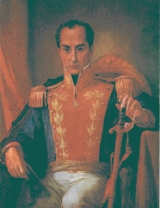
, Venezuela
– December 17, 1830, Santa Marta, Colombia) was a Venezuelan military and political leader. Together with José de San Martín
, he played a key role in Hispanic-Spanish America's successful struggle for independence from the Spanish Empire
, and is today considered one of the most influential politicians in Latin American history.
Following the triumph over the Spanish Monarchy
, Bolívar participated in the foundation of the first union of independent nations in Hispanic-America, a republic, which was named Gran Colombia
, and of which he was president from 1819 to 1830.
1813 South American independence leader Simón Bolívar enters Mérida, leading the invasion of Venezuela, and is proclaimed ''El Libertador'' ("The Liberator").
1813 Battle of Bárbula: Simón Bolívar defeats Santiago Bobadilla.
1819 Simón Bolívar triumphs over Spain in the Battle of Boyacá.
1819 Simón Bolívar declares the independence of the Republic of Gran Colombia in Angostura (now Ciudad Bolívar in Venezuela).
1821 The Republic of Gran Colombia (a federation covering much of present day Venezuela, Colombia, Panama, and Ecuador) is established, with Simón Bolívar as the founding President and Francisco de Paula Santander as vice president. thumb|right|220px|[[Brazil]] declares independence.
1822 José de San Martín arrives in Guayaquil, Ecuador, to meet with Simón Bolívar.
1823 Simón Bolívar is named President of Peru.

